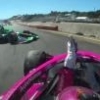DRS is, and always has been since its introduction, a necessary evil until they actually get the cars raceable. I'm all in favour of removing it - but as long as the cars are actually capable of racing each other, which at present, and for the last few years, they haven't been.
I didn't bother watching the last race live, since it seemed inevitable it was going to be a dud. But it was funny reading the replies to the topic. People were complaining how boring the race was without DRS, and then others complaining when it was reactivated. ![]() Guess there's no pleasing everyone!
Guess there's no pleasing everyone!
I don't get the appeal in just seeing a train of cars. How is that exciting, when we know that it is very unlikely to change? It's not really much of a "battle" if overtaking isn't actually possible...
I get the argument against "flybys" - and it amazes me how, even all these years later, F1 is still getting it wrong and making the DRS too powerful/not powerful enough. How hard can it be to get it so that it gives the following driver enough of an advantage to attempt a pass into the braking zone, but not just sail on by?
So yeah, fix the cars first (which hopefully 2021 will do) then we can talk about removing DRS. But before then? No.



















